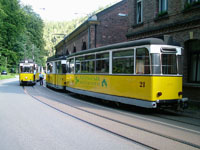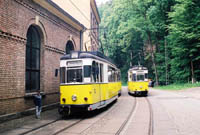BAD SCHANDAU TRAMWAY NETWORK
[Back]
CITY
[as of 06.2010]
A town of 2,999 inhabitants in the eastern part of Germany, located 6 km. west of the Czech border, on the banks of the Elbe River.
NETWORK
[06.2010]
An interurban tram line known as Kirnitzschtalbahn begins at the eastern outskirts of the town and follows an intercity road via a remote picturesque canyon surrounded by high cliffs. The line ends at the guesthouse at the Lichtenhainer waterfall, which is a starting point for hikes through the popular Sachsische Sweiz National Forest. Even though the line mainly caters to tourists, it remains a transportation node, rather than a tourist attraction. There is also a small but loyal constituency of local riders using the line for everyday transportation needs.
HISTORY
[06.2010]
28.05.1898 - Bad Schandau Hotel Lindenhof - Lichtenhainer Wasserfall
23.06.1969 - The section Hotel Lindenhof - Stadtpark closes, and the line is cut back 350 m., as the old terminal's layout became obsolete considering modern motorized traffic patterns.
21.07.1969-24.07.1972 - Following a serious accident caused by a dilapidated trackage, the line is closed for a complete renovation.
05.12.1985-16.07.1986 - The line is closed for additional renovations.
05.10.1993-01.05.1994 - The line is closed for additional renovations.
RIGHT-OF-WAY
[06.2010]
The 7,9 km. line is entirely single-track, with two passing points and dual-track stub end terminals. The gauge is 1000 mm. The line is built as a mixed traffic right-of-way, and follows the southern side of Kirnitzschtalstrasse, a west-east intercity road, with all stops located on the southern side of the road. Thus, westbound (town-bound) trams operate in perpetual state of conflict with the eastbound motorized traffic. Bypassing of westbound trams occurs by way of westbound cars (moving parallel to trams) having to stop and yield to eastbound cars that swerve into the westbound lane to avoid trams. Such operation is only possible under light traffic conditions.
The tram line layout and infrastructure in general did not change with time, which provides for a timeless atmosphere. Between 1985-1990, however, a rehab of the line was started under the GDR, upon which concrete blocks were laid between tracks in some places, and authentic overhead support poles were lost, replaced with steel industrial substandard ones. In 2003-2004 the project was finished as the road was repaved, upon which cobblestones were removed.
This single-track operation is maintained by way of passing a single rod between drivers of opposing vehicles, which corresponds to each section of the track.
SERVICE
[06.2010]
November - March:
9:50-15:40: 70 min. headway
April - October:
8:15-9:00: 45 min. headway
9:00-19:00: 30 min.
19:00-20:40: 45-55 min.
After 18:00 each 2nd trip is operated to Forsthaus only.
One additional school trip is operated throughout the year on school days one-way between Ostrauer Muhle - Stadtpark at 7:25.
The entire tram line is duplicated by a popular suburban bus route 241, which operates as often as the tram does (more often during low season). Both tram and bus routes are operated by the same entity - the OPS company from the neighboring town of Pirna.
Fares are collected by an operator walking through cars at terminals (or a second employee stationed at terminals during high season) prior to a departure. While in route, fares are payable to the operator when boarding the front car only.
30% of power used for operation is generated with solar panels mounted on the Depot's roof.
ROLLING STOCK
[06.2010]
Trailers:
 |
12
MAN (1928)
Historic double-ended car
(Cars of this type operated in service 1928-1991)
(17.05.1996, Frank Hohmann)
|
 |
21
Gotha B2-62 (1963)
Single-ended car
Body: ex-Leipzig; chassis: ex-Halle (1984)
(23.08.2008, Yury Maller)
|
 |
22
Gotha B2-62 (1963)
Single-ended car
Body: ex-Leipzig; chassis: ex-Halle (1984)
(23.08.2008, Yury Maller)
|
 |
23
Gotha B2-62 (1963)
Single-ended car
Body: ex-Leipzig; chassis: ex-Halle (1984)
(01.06.2002, Frank Hohmann)
|
 |
24
Gotha B2-62 (1963)
Single-ended car
Body: ex-Leipzig; chassis: ex-Halle (1984)
(26.05.2003, Yury Maller)
|
 |
25
Gotha B2-64 (1966)
Single-ended car
Ex-Zwickau (1995)
(23.08.2008, Yury Maller)
|
 |
26
CKD B2D (1968)
Single-ended car (car in the middle on this photo)
Ex-Zwickau (1995)
(23.08.2008, Yury Maller)
|
All motor cars are double-ended. Doors on the north side are blocked off as all stops are located on the south side. All trailer cars are single-ended, positioned in a way that doors would always face south. All service cars are cosmetically rebuilt, yet with the exception of new more comfortable seats, a traditional Gotha-car interior is preserved.
All original 6 motor and 6 trailer 1898 Bautzen/Busch cars perished in the catastrophic 27.07.1927 depot fire. A fleet of replacement 1928 MAN cars was operated until 1983 (trailers until 1991). MAN motor cars were replaced by 5 Gotha/AEG motor cars of Erfurt type (1938-1944) that arrived in 1977 from the neighboring Lockwitztalbahn. The latter line operated in the Dresden's southern suburb, but was closed 18.12.1977. Erfurt-type motor cars operated well into the mid-1990s, when they were replaced with 4 "next generation" 1957-1960 Gotha/LEW motor cars, received in 1992-1995 second hand from Plauen (3 cars) and Zwikau (1 car). The first 4 Gotha trailers entered service in Bad Schandau in 1984. They were assembled out of car bodies delivered second hand from Leipzig, and 1000 mm chassis from Halle. A low-floor MGT6D tram from Halle operated on the system 13.07-19.08.1993 as a test vehicle. Similar vehicle was brought in again for the 100th anniversary events in 1998.
Three trains are operated when the headway is 30 min. during high season. In most cases these are 2-car motor+trailer trains. When 2-car trains are in use, one additional trailer is stationed at each terminal in an anticipation of heavier trips. 3-car motor+trailer+trailer trains are usually operated during the first half of weekend days in the summer, or for any trip that is heavier than usual. A single motor car could be operated for light evening trips. One train only is operated when the headway is 70 min. during low season - usually a single motor car.
Bad Schandau is the only system in the world where traditional Gotha motor+trailer+tailer trainsets are still operated.
[Back]














